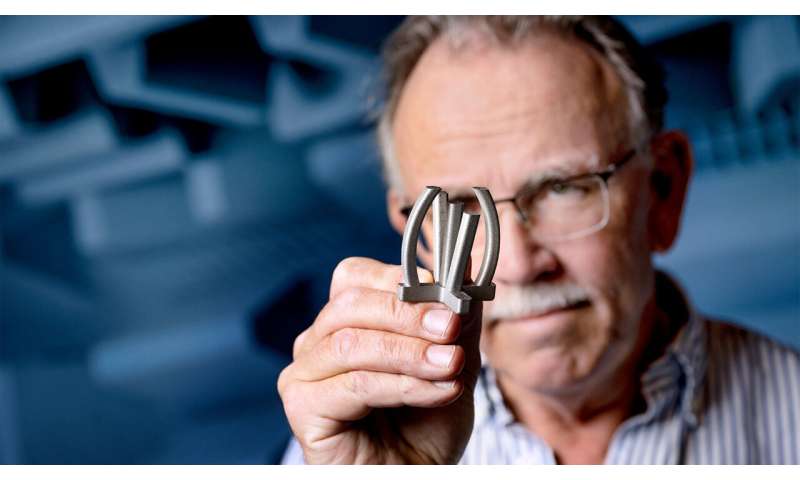
When the next crew departs for the International Space Station ISS, a metal 3-D printer will be aboard. The printer will eventually be used to produce spare parts on the ISS. It will also contribute to new knowledge which can help to improve the use of resources here on Earth.
From a space station hundreds of kilometers above the Earth’s surface, there is—as DTU Professor and space instrument and technology expert John Leif Jørgensen points out—a long way to the workshop if you suddenly need a spare part that you do not have in stock. A metal 3D-printer could be the answer to this problem.
It is for this reason that the Huginn team, led by Danish Astronaut Andreas Mogensen on the ISS, will test a brand new printer. Airbus developed the printer specifically for ESA, European Space Agency. “Such a printer can produce exactly the bits you need up there,” says John Leif Jørgensen.
The printer has a nozzle which sprays stainless steel wire. The printer moves while a laser beam melts a stainless-steel wire, forming the pattern desired and creating the object.
“Technically, it’s just small welding wires that you melt in place with a Laser beam. The professor says that it will allow for the production of complex objects outside of a traditional production hall.
Airbus can gain important insights from its visit to the ISS on what modifications may be necessary to enable it to manufacture space spare parts at a greater scale.
Knowledge about differences provides important insight
As part of the program, astronauts are going to print out copies of a 5-cm-tall structure that has been carefully designed. DTU researchers have created similar models here on Earth. Researchers will measure the models accurately when the Huginn crew arrives to see if there are any differences.
Gravity affects everything made on Earth. It means that the physical effects can vary along with gravity. This can be caused by the fact that materials may warp when heated and cooled in different ways. The absence of gravity on ISS will minimize such built-in tensions in the printed figures,” John Leif Jørgensen explains.
The mapping of differences between objects printed in Earth’s atmosphere and those printed in space will allow scientists to find answers to questions fundamental about the behavior of metals under different thermal and mechanical conditions.
This deeper insight into materials physics can, for example, be used to reduce the margin of safety that manufacturers of metal objects use here on Earth—and thus reduce resource consumption, John Leif Jørgensen explains, “For example, parts for, e.g., aircraft are built substantially stronger than necessary because we don’t know exactly how the materials behave. It is also true for cars, bicycles, etc. You could improve the efficiency of using many of the materials and components we use today in our society if you reduce the safety margin responsibly and get closer to the limits.”
DTU Space projects
Huginn is expected to be launched in August.
One of the projects aims to test virtual reality as a tool that can stimulate mental well-being on a space mission. A consortium headed by DTU will deliver a VR system that can transport astronauts to peaceful places—such as a trickling stream in a forest—and thereby improve the astronauts’ mental well-being on long missions.
It’s a challenge to create equipment that works in space. The available VR systems make use of gravity to ensure that the universe presented to the user is oriented correctly and that it displays without images “flickering” when—for example—the astronauts turn their heads.
It will be a huge undertaking to create a system which works just as well at zero gravity and does not make astronauts feel motion sick. It is possible that if the system works as planned, it could be applied to VR in space, for entertainment, training and practice.
In the second project, Andreas Mogensen will continue to capture the powerful lightning which emanates from thunderclouds and reaches up to a height of 50 kilometers—and which he captured on video during his first brief mission in 2015.
DTU Space will supply the Danish astronaut for the new mission with a better camera system that can capture up to 100,000 pictures per second. The images captured by the system provide a contrast unprecedented in the electric activity.
The many new images—together with data collected from the Danish space climate observatory ASIM, where DTU Space is responsible for the scientific management—will provide DTU researchers with more knowledge about how lightning affects the atmosphere’s concentration of greenhouse gases and thereby Earth’s climate.
For example, researchers will be able improve their climate models with this information.
Technical University of Denmark
Citation:
Printing spares in zero gravity (2023 – June 6)
Retrieved 7 June 2023
from https://sciencex.com/wire-news/447527089/printing-spare-parts-in-zero-gravity.html
Copyright applies to this document. This document is protected by copyright.
Parts may not be reproduced without permission. Content is provided solely for informational purposes.